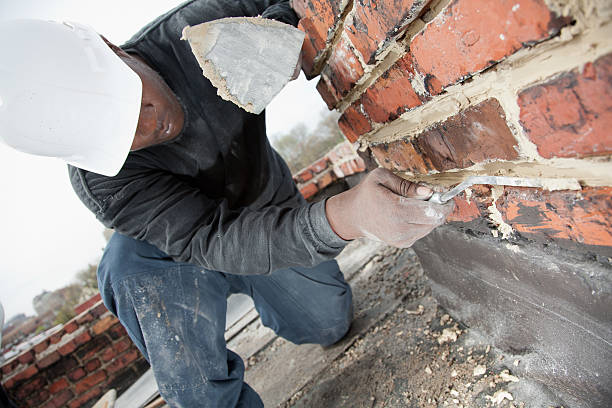Unlocking the Secrets of Lasting Stonework Building Practices for Eco-Friendly Buildings
Among the myriad strategies to eco-friendly building, lasting stonework construction stands out as a reliable and sturdy method that holds a wide range of untapped capacity. From the selection of products to innovative building and construction strategies, the secrets to achieving sustainability within masonry building and construction are complex and appealing.
Benefits of Lasting Stonework Construction
Accepting lasting stonework construction practices not only reduces ecological impact yet additionally offers lasting economic advantages to home builders and areas. By utilizing materials like recycled bricks, blocks, and rocks, contractors can dramatically reduce the carbon footprint of their projects while advertising resource effectiveness. In addition, sustainable masonry construction methods, such as appropriate insulation and thermal mass homes, can boost power effectiveness within structures, resulting in reduced operational costs in time.
Additionally, the resilience and durability of masonry structures add to long-term economic advantages. Structures built making use of sustainable stonework practices frequently require much less repair and maintenance, converting to set you back financial savings for builders and property owners. The durability of masonry materials also makes sure that structures remain secure and protected, lowering the need for frequent renovations or substitutes.
Eco-Friendly Stonework Materials
Utilizing environment-friendly stonework materials is a critical step towards boosting the sustainability of building techniques and decreasing ecological effect while taking full advantage of long-lasting financial advantages. Lasting stonework materials are sourced, generated, and utilized in a fashion that reduces total ecological influence. Products such as recycled bricks, reclaimed rock, and sustainable cinder block are becoming significantly preferred choices for eco-conscious builders. Recycled blocks, for example, not only draw away waste from land fills however additionally require much less power to generate contrasted to brand-new blocks. Reclaimed stone provides an unique visual appeal while decreasing the requirement for new quarrying. Lasting concrete obstructs integrate recycled aggregates and might feature improved insulation residential properties, adding to energy efficiency in buildings.
Additionally, all-natural materials like adobe, rammed earth, and straw bales give superb thermal mass homes, reducing the demand for heating and cooling down energy. These products are usually locally offered, promoting regional economic situations and lowering transportation-related carbon exhausts. By choosing green masonry products, construction tasks can substantially decrease their environmental impact and add to the production of much healthier, much more sustainable developed environments.
Energy-Efficient Masonry Methods
Power performance plays a critical duty in boosting the sustainability of masonry building and construction methods. By implementing energy-efficient masonry strategies, home builders can considerably minimize the overall power consumption of a building, resulting in lower functional expenses and a smaller ecological footprint. One essential energy-efficient masonry method is making use of thermal mass, which entails incorporating thick products like concrete or block into the structure's framework to absorb and keep warm. This helps regulate interior temperature levels, lowering the requirement for mechanical heating and cooling down systems.

Advancements in Sustainable Stonework
Recent advancements in lasting masonry methods have produced cutting-edge strategies that are reshaping the building and construction market. One such innovation is the advancement of self-healing concrete, which makes use look at here now of germs embedded within the concrete to heal splits autonomously. This advancement not just reduces maintenance expenses yet also boosts the sturdiness of stonework structures, adding to their sustainability.
An additional notable development is the usage of recycled aggregates in masonry building - masonry contractor. By including materials such as crushed ceramic waste or recycled glass into concrete blends, contractors can minimize the ecological impact of building and construction projects while keeping architectural honesty. This practice not only diverts waste from garbage dumps but also preserves natural deposits, making it a vital advancement in sustainable masonry construction
Moreover, the assimilation of electronic layout devices, such as Structure Information Modeling (BIM), is revolutionizing the way masonry structures are planned and constructed. BIM permits more specific estimations, lowered product wastefulness, and enhanced energy effectiveness, eventually leading to even more lasting structure techniques. These developments collectively signify a promising future for sustainable masonry building in the age of eco-friendly structures.
Future Trends in Stonework Sustainability
With the ingenious strides made in sustainable stonework techniques, the future patterns in masonry sustainability are poised to additional reinvent the building industry. Among the crucial patterns shaping the future of stonework sustainability is the boosted integration of modern technology. Innovations such as Structure Information Modeling (BIM) and virtual reality simulations are being used to optimize stonework building procedures, bring about lowered material waste and boosted power effectiveness in buildings.
In addition, her response the advancement of novel lasting materials is set to play a significant role in enhancing the eco-friendliness of masonry building. masonry contractor. Innovations like self-healing concrete, recycled accumulations, and bio-based binders are getting traction for their capacity to reduce ecological impact while keeping structural stability

Verdict
Finally, sustainable masonry building techniques supply numerous benefits for environmentally friendly structures. By using environmentally friendly materials and energy-efficient methods, stonework can add to an extra lasting constructed setting. Technologies in lasting stonework are constantly being established to even more improve the environmental performance of buildings. Looking towards the future, the trend of masonry helpful hints sustainability is anticipated to grow, causing more ecologically pleasant and energy-efficient building and construction techniques in the years ahead.